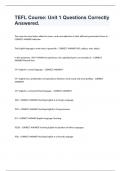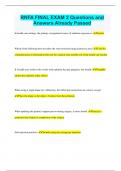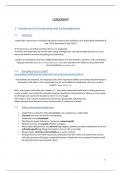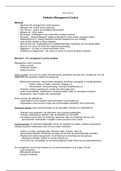UNIVERSITY OF OXFORD Last updated: September 16, 2013
Department of Economics
Undergraduate - Microeconomics
Tutorial/Class 6: Risk & Expected Utility; Insurance
Sketch solutions
FOR USE BY TUTORS ONLY
DO NOT CIRCULATE, ESPECIALLY TO STUDENTS
, Problems and Multipart Questions
1. Your Utility Function
There is no ‘correct’ answer to this first question – your answer will depend on your
own attitude to risk.
Suppose you are o↵ered a gamble (£x, £y; ⇡) – that is, with probability ⇡ you get £x
and with probability 1 ⇡ you get £y. What would be your certainty equivalent (CE)
for the gamble if x = 0, y = 1000, and ⇡ = 12 ? Call this amount c. Now write down
your CEs for each of the gambles (0, £c; 12 ) and (£c, £1000; 12 ). Use this information
to plot the shape of your utility function.
(You need to think carefully about your CEs – what would you choose if you were
really o↵ered these gambles. See Kreps 3.6 for discussion of this kind of exercise.)
In this context, their utility function u(·) is cardinal, i.e. the only
transformations that ensure that we still have an EU representation of preferences
over lotteries is v(·) = ↵+ u(·), for any ↵ and any > 0. With w denoting initial
wealth, deciding where to plot (0, u(w)) fixes the location parameter ↵, and deciding
where to plot (1000, u(w+1000)) fixes the scale parameter ; the other points are
determined only by the three CEs they are asked to come up with -- see (b) below.
Although there is no ‘correct’ answer to this question, there are some incorrect
ones.
(a) I would be surprised if u(w) > u(w+1000), and in general if u were plotted
as not increasing.
(b) Whatever the value of c, u(w + c) should be plotted half way between u(w)
and u(w + 1000) -- this is from the definition of CE.
Similarly the first of the other two CEs should be plotted half way between u(w)
and u(w + c), and the second half way between u(w + c) and u(w + 1000).
Apart from that, pretty much anything goes ...
2. Certainty Equivalent; Risk Premium; Risk Spreading and Pooling
(a) Bill’s initial wealth is 22. He can invest it all in a risky project that has a 50:50
chance of succeeding. If he invests and the project succeeds, his final wealth will
be 40, but if it fails, his final wealth will be 10. Bill’s preferences over monetary
outcomes, y, are summarised by the utility function u(y) = ln y. For him, what is
the certainty equivalent of this project? What is the risk premium? Why should
he reject the opportunity to invest in the project?
Expected Utility = 12 ln 10 + 12 ln 40 = 1
2 ln 400 = ln 20, i.e. u(20), therefore the
certainty equivalent is 20.
1
Expected outcome = 2 10 + 12 40 = 25, therefore the risk premium is 5,
i.e. 25 20.
Bill’s initial wealth of 22 is greater than 20, the certainty equivalent of
the project, so he should reject the opportunity to invest.
1
Department of Economics
Undergraduate - Microeconomics
Tutorial/Class 6: Risk & Expected Utility; Insurance
Sketch solutions
FOR USE BY TUTORS ONLY
DO NOT CIRCULATE, ESPECIALLY TO STUDENTS
, Problems and Multipart Questions
1. Your Utility Function
There is no ‘correct’ answer to this first question – your answer will depend on your
own attitude to risk.
Suppose you are o↵ered a gamble (£x, £y; ⇡) – that is, with probability ⇡ you get £x
and with probability 1 ⇡ you get £y. What would be your certainty equivalent (CE)
for the gamble if x = 0, y = 1000, and ⇡ = 12 ? Call this amount c. Now write down
your CEs for each of the gambles (0, £c; 12 ) and (£c, £1000; 12 ). Use this information
to plot the shape of your utility function.
(You need to think carefully about your CEs – what would you choose if you were
really o↵ered these gambles. See Kreps 3.6 for discussion of this kind of exercise.)
In this context, their utility function u(·) is cardinal, i.e. the only
transformations that ensure that we still have an EU representation of preferences
over lotteries is v(·) = ↵+ u(·), for any ↵ and any > 0. With w denoting initial
wealth, deciding where to plot (0, u(w)) fixes the location parameter ↵, and deciding
where to plot (1000, u(w+1000)) fixes the scale parameter ; the other points are
determined only by the three CEs they are asked to come up with -- see (b) below.
Although there is no ‘correct’ answer to this question, there are some incorrect
ones.
(a) I would be surprised if u(w) > u(w+1000), and in general if u were plotted
as not increasing.
(b) Whatever the value of c, u(w + c) should be plotted half way between u(w)
and u(w + 1000) -- this is from the definition of CE.
Similarly the first of the other two CEs should be plotted half way between u(w)
and u(w + c), and the second half way between u(w + c) and u(w + 1000).
Apart from that, pretty much anything goes ...
2. Certainty Equivalent; Risk Premium; Risk Spreading and Pooling
(a) Bill’s initial wealth is 22. He can invest it all in a risky project that has a 50:50
chance of succeeding. If he invests and the project succeeds, his final wealth will
be 40, but if it fails, his final wealth will be 10. Bill’s preferences over monetary
outcomes, y, are summarised by the utility function u(y) = ln y. For him, what is
the certainty equivalent of this project? What is the risk premium? Why should
he reject the opportunity to invest in the project?
Expected Utility = 12 ln 10 + 12 ln 40 = 1
2 ln 400 = ln 20, i.e. u(20), therefore the
certainty equivalent is 20.
1
Expected outcome = 2 10 + 12 40 = 25, therefore the risk premium is 5,
i.e. 25 20.
Bill’s initial wealth of 22 is greater than 20, the certainty equivalent of
the project, so he should reject the opportunity to invest.
1











